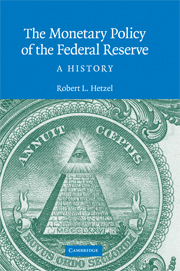Book contents
- Frontmatter
- Contents
- Figures
- Preface
- 1 The Pragmatic Evolution of the Monetary Standard
- 2 Learning and Policy Ambiguity
- 3 From Gold to Fiat Money
- 4 From World War II to the Accord
- 5 Martin and Lean-against-the-Wind
- 6 Inflation Is a Nonmonetary Phenomenon
- 7 The Start of the Great Inflation
- 8 Arthur Burns and Richard Nixon
- 9 Bretton Woods
- 10 Policy in the Ford Administration
- 11 Carter, Burns, and Miller
- 12 The Political Economy of Inflation
- 13 The Volcker Disinflation
- 14 Monetary Policy after the Disinflation
- 15 Greenspan's Move to Price Stability
- 16 International Bailouts and Moral Hazard
- 17 Monetary Policy Becomes Expansionary
- 18 Departing from the Standard Procedures
- 19 Boom and Bust: 1997 to 2001
- 20 Backing Off from Price Stability
- 21 The Volcker–Greenspan Regime
- 22 The Fed: Inflation Fighter or Inflation Creator?
- 23 The Stop–Go Laboratory
- 24 Stop–Go and Interest Rate Inertia
- 25 Monetary Nonneutrality in the Stop–Go Era
- 26 A Century of Monetary Experiments
- Appendix: Data Seen by FOMC for the Stop–Go Period Shown in Figures 24.1, 24.2, and 24.3
- Notes
- Bibliography
- Index
- Titles in the series
7 - The Start of the Great Inflation
Published online by Cambridge University Press: 26 May 2010
- Frontmatter
- Contents
- Figures
- Preface
- 1 The Pragmatic Evolution of the Monetary Standard
- 2 Learning and Policy Ambiguity
- 3 From Gold to Fiat Money
- 4 From World War II to the Accord
- 5 Martin and Lean-against-the-Wind
- 6 Inflation Is a Nonmonetary Phenomenon
- 7 The Start of the Great Inflation
- 8 Arthur Burns and Richard Nixon
- 9 Bretton Woods
- 10 Policy in the Ford Administration
- 11 Carter, Burns, and Miller
- 12 The Political Economy of Inflation
- 13 The Volcker Disinflation
- 14 Monetary Policy after the Disinflation
- 15 Greenspan's Move to Price Stability
- 16 International Bailouts and Moral Hazard
- 17 Monetary Policy Becomes Expansionary
- 18 Departing from the Standard Procedures
- 19 Boom and Bust: 1997 to 2001
- 20 Backing Off from Price Stability
- 21 The Volcker–Greenspan Regime
- 22 The Fed: Inflation Fighter or Inflation Creator?
- 23 The Stop–Go Laboratory
- 24 Stop–Go and Interest Rate Inertia
- 25 Monetary Nonneutrality in the Stop–Go Era
- 26 A Century of Monetary Experiments
- Appendix: Data Seen by FOMC for the Stop–Go Period Shown in Figures 24.1, 24.2, and 24.3
- Notes
- Bibliography
- Index
- Titles in the series
Summary
Stop–go monetary policy began in Martin's final years as FOMC chairman. Why did he allow monetary policy to become inflationary?
The Spirit of Stop–Go Monetary Policy
In the 1960s, a demand for activist macroeconomic policy arose from a convergence of political imperative and intellectual consensus. An imperative for growth emerged out of the fiscal pressures created by the Vietnam War and the social divisions created by the war and the civil rights movement. President Johnson refused to choose between war expenditures and his Great Society programs. The economy had to grow flat-out to generate the revenues necessary to pay for guns and butter.
Riots in inner cities and the rhetoric of black militants polarized American society. The middle class watched in dismay as the pampered baby boom generation of students burned the American flag in street demonstrations. A political consensus arose on the need to maintain a rapidly growing economy and a low unemployment rate as a social balm for a deeply divided society. At the same time, a consensus existed within the economics profession that government should pursue an activist policy of aggregate demand management to assure steady growth and low unemployment. Keynesian economics promised to deliver the political imperatives of high growth and low unemployment.
With stop–go, policymakers pursued expansionary monetary policy when the unemployment rate was “high” under the assumption that aggregate-demand inflation could not arise with excess capacity in the economy.
- Type
- Chapter
- Information
- The Monetary Policy of the Federal ReserveA History, pp. 67 - 76Publisher: Cambridge University PressPrint publication year: 2008

